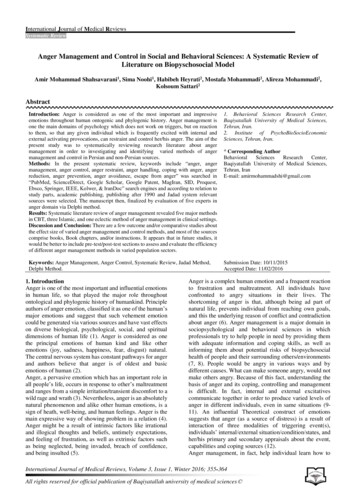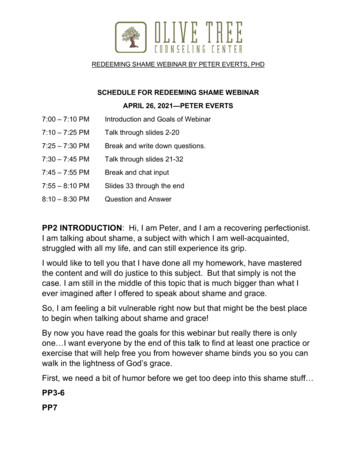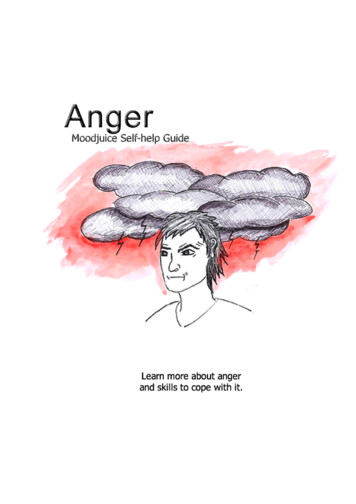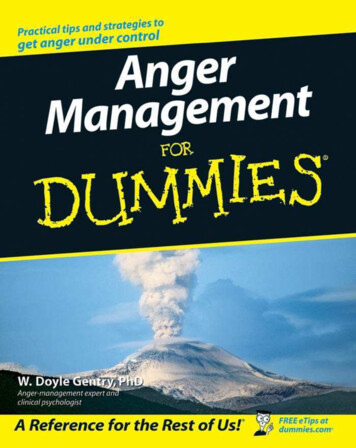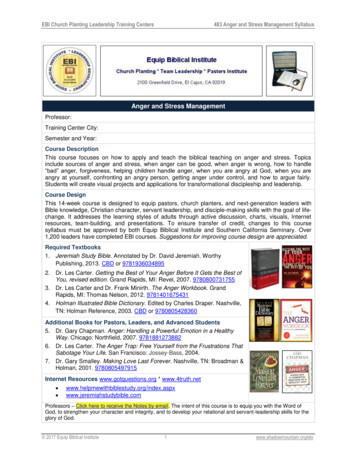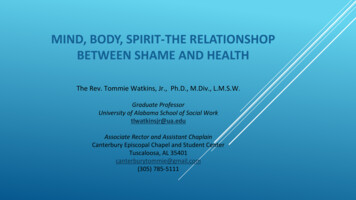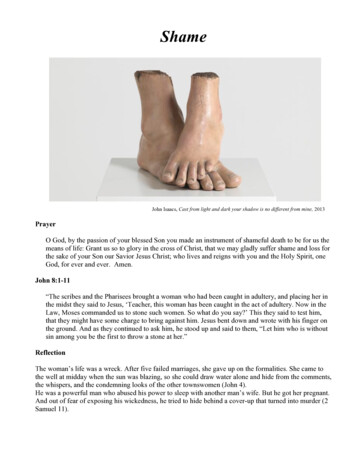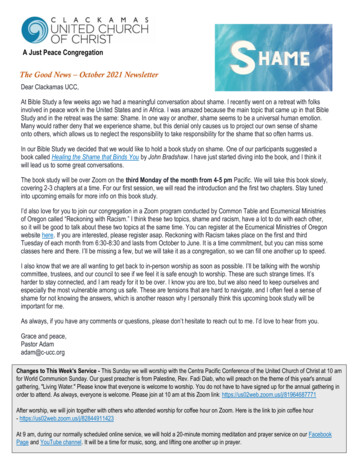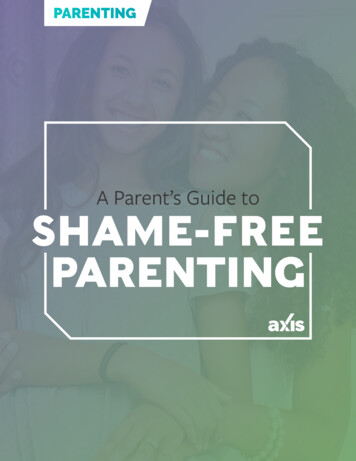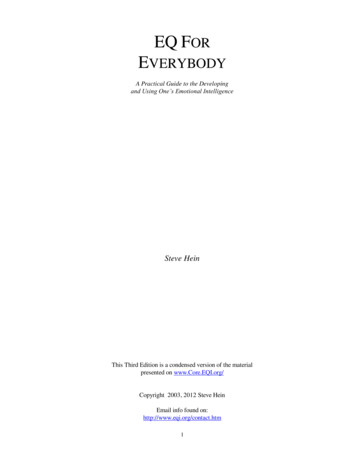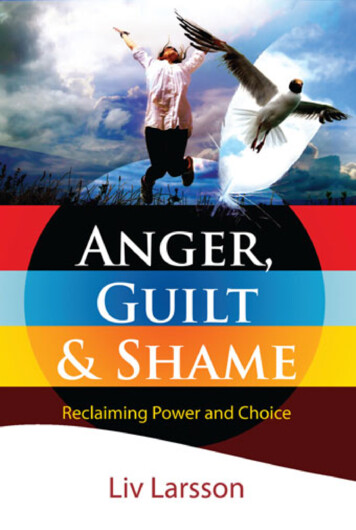
Transcription
Anger, Guilt & ShameReclaiming Power and ChoiceLiv Larssonwww.friareliv.seAnger Guilt and Shame - Reclaiming Power and ChoiceLiv Larsson1
If you have not purchased this book directly from us, e-mail or call us if youwish to receive our book catalogue and newsletter. Copyright: Liv Larsson 2012. First published in Swedish 2010Original title “Ilska, skuld & skam, tre sidor av samma mynt.All rights reserved. No part of this book may be reproduced by any mechanical,photographic, or electronic process, or in the form of a photographic recording, normay it be stored in a retrieval system, transmitted, or otherwise copied for public orprivate use without the written permission of the publisher. Requests for permissionshould be adressed to:Friare Liv ABMjösjölidvägen 477946 40 SvensbynSwedenPhone: 46 911 24 11 44info@friareliv.sewww.friareliv.se/engAuthor: Liv LarssonTranslation: Liv Larsson and Birgitta NilssonEnglish editing and language support: Belinda PoropudasProof reading: Annett ZupkeLayout: Kay RungCover design: Vilhelm PH Nilsson www.communicationforlife.org/vilhelm/ISBN 978-91-979442-8-1 printISBN 978-91-980592-4-3 epubISBN 978-91-980592-5-0 kindelISBN 978-91-87489-03-7 pdf2Anger Guilt and Shame - Reclaiming Power and ChoiceLiv Larsson
ContentPreface by the Author 8Chapter 1Shame, Guilt and Anger10Our Way of Thinking Creates ProblemsNatural Versus Cultural14An Approach for Change1612Chapter 2The Myth of Domination in Our Everyday LifeEducation for Peace 19Our Myths Shape Our World.20Shame on You!24On the Scene of a Domination Culture27Domination Cultures Versus Partnership CulturesViolence Between the Words 311829Chapter 3Anger, Guilt, Shame and Our Way of CommunicatingNonviolent Communication (NVC) 39Looking Forward to the Next Time You Feel Shame 39An Approach That Leads to Connection40“What They Did Was Wrong” 48Anger and Needs50Shame and Needs51Guilt and Needs51“It’s My Fault” 52The Difference Between Needs and Strategies 52Guilt-inducing Communication55Never Do Anything to Avoid Shame and Guilt57Humor or Empathy 58Empathy58Anger Guilt and Shame - Reclaiming Power and ChoiceLiv Larsson383
Empathy Versus Sympathy59Empathy and Shame62Empathy and Anger62Empathy and Guilt63Empathy Instead of “Sorry” 68Apologize with NVC69Self-Empathy69Mourning Without “Getting Lost”70The Shame-inducing Word “No”71Three Precious Assumptions About “No”72The Language of Needs Leads to Connection 73With Anger and Shame Transformed 74Chapter 4The Shame Adventure 78When Shame Takes Over79What Stimulates Shame82Shame Bingo 93What Is Shame?95When Shame Goes Sour98Shame Can Be Managed99Taking Advantage of Shame 100From Shame to Connection 102Shame and Vulnerability103Being Ashamed of Feeling Ashamed 104Innate Shame 106Cultural Shame107Disgust and Dissmell 109Time Goes, Shame Stays110The Shame of Untidiness110Shame Gets in the Way of Learning 111Childhood Shame113Teenage Shame114The Place of Shame in Child Rearing 116Reasons Why it Could Be Wrong to Steal4117Anger Guilt and Shame - Reclaiming Power and ChoiceLiv Larsson
Shame and Honor118To Take on Somebody Else’s ShameSex and Shame121Practice Dealing with Shame 123120Chapter 5The Compass of Needs130Learning to Recognize Shame 131Whose Fault Is It?132Who Has the Power? 133Four Directions for Dealing with Shame133What Does Your Compass Show?1341. We Withdraw1352. Looking for What Is Wrong With Ourselves3. Rebellion - Invading the Feeling of Shame 1424. Looking for What is Wrong With Others 146Summary149Supporting Others in Dealing With Shame 150From Shame to Vulnerability 154Chapter 6Pride 158Pride Goeth Before a Fall?159Pride and Appreciation160Shame of Appreciation161Three Types of Pride 162To Be Ashamed of Somebody Else139165Chapter 7The Surprising Purpose of Anger 168Rapid Transformation 169The Core of Violence 170Entertainment Violence171The Lost Way of Using Anger 173Anger – an Alarm Bell 174Anger Guilt and Shame - Reclaiming Power and ChoiceLiv Larsson5
Count to Ten 175From Shame to Anger to Violence176When We See Anger as Something WrongGive - But Only If It Is Voluntary178Behind the Anger Shame Is Lurking 180Angry Women 180Children’s Anger181To Protect Rather Than to Punish182Practice Anger Management 185Transform Your Anger 186Express Anger After Having Transformed It176188Chapter 8Nagging Guilt 190The Difference Between Shame and Guilt193Guilt and Shame-inducing194Restructuring Guilt - Transforming Guilt to NeedsTransforming Guilt 197Stop Playing God!198Guilt and Demands 199Scapegoating 200Self-confidence and Self-esteem202Freedom from Guilt 203Money and Guilt204Inventory of What Stimulates Guilt 206An Exciting Day of Exploring Guilt 207AfterwordReferenceDVD, CD195209210213About the Author 214Also by Liv Larsson in English6Anger Guilt and Shame - Reclaiming Power and ChoiceLiv Larsson
Anger Guilt and Shame - Reclaiming Power and ChoiceLiv Larsson7
Preface by the AuthorMy partner and I sometimes tease each other about situations whereeither he or I have been really angry with each other. When we are askedwhat the conflict was about, retrospectively we surprisingly seldomremember what it was that triggered the anger. We remember someof the expressions we used and the less flattering actions we acted out.Although the cause of the conflict in the moment when it occurredseems to be the most important thing in the world, after a while we donot even remember how the fight started. During the worst raging ofthe storm, our respective positions seem extremely important. In orderto be the one who is right, we are ready to use language and actionsthat are violent in one way or another. Later, when we searched for thecore of our conflicts, we found often that they were about autonomy,care and respect. And that it is these values or needs that are important.Slowly, step by step, I have began to understand that when I blamemy feelings on others, I miss an opportunity to develop and learnsomething about myself. It has helped me to use the energy that Ipreviously wasted on criticizing others, to change the things I wantto change.If we - instead of blaming others when we are angry - take responsibility for what is going on within us, we can find constructive waysto express ourselves. To connect what we feel to what we need willopen doors to dialogue and make it easier to meet everyone’s needs.If no one has to give up their needs in a conflict, it will benefit all ourrelationships.It took me several years after my first training in NonviolentCommunication (NVC) to understand the meaning of what MarshallRosenberg, who developed NVC, meant when he said, “Never doanything to avoid shame and guilt.” As I explored this advice in depth,I discovered that my understanding of communication between peopledeepened. I also saw how shame, guilt and anger are potent keys toconnect to my heart.Working on this book, I discovered that often hidden behind angerand guilt, is shame and a desire to experience respect. To get in touchwith our needs, we also need to get in touch with shame as we explore8Anger Guilt and Shame - Reclaiming Power and ChoiceLiv Larsson
anger and guilt. If we get to know shame it makes a big difference inour ability to deal with anger and guilt, so I have chosen to search fora deeper understanding of the concept of shame.When I immersed myself in the concept of shame and began touse the compass of needs that I describe in chapter five, it deepenedmy sense of freedom in life. It has been a great investment of timeand energy, to connect with and to make friends with anger, guiltand shame.I have also had the privilege to learn from other people’s experiences - including people taking part in my trainings on the subject - ofusing the compass of needs.With the help of this book, I hope you will be pleasantly surprisedthat it actually is not that difficult to create the life you are longingfor. You will see that in every moment it is possible to connect deeperto the life within you, and that guilt, shame and anger can becomenew friends in this exploration.I also hope I have managed to show how shame, guilt and angerintimately intermingle and that they are based on a mind-set that wehave learned over the past eight thousand years. Although this bookis largely about how you as an individual can deal with anger, shameand guilt in more efficient ways, I see these emotions primarily as aresult of the domination systems we have been socialized into. Onlywhen we can change this system from its core, will I have the confidence that we can really change our way of life. Our humanity andour social structures, will then, bit by bit, change to become more inthe service of life.My vision is that a person born today will be amazed if she or heis reading this book in about 30 years. She or he will ponder what onearth we were doing, and marvel at why we really needed all thesetools to manage something that for them seems so simple.Liv LarssonAnger Guilt and Shame - Reclaiming Power and ChoiceLiv Larsson9
Chapter 1Shame, Guilt and Anger10Anger Guilt and Shame - Reclaiming Power and ChoiceLiv Larsson
Shame, Guilt and Anger“We cannot solve problems with the same thinking that created them.”Albert Einstein1My interest in anger, guilt and shame began when I discovered that thereason why it is often challenging to deal with these emotions has todo with how they are connected to a certain way of thinking. This wayof thinking is a part of most contemporary cultures and can be seenas “a culture within a culture”. Behind this thinking there are feelingsand needs that we sometimes forget, because we focus more on whois right and who is wrong than on what we need. By becoming awareof what we need we can discover new ways of thinking and relating.The assumptions this book is based on are:Shame, guilt and anger are life-serving signals.We have misinterpreted these signals.We need to reinterpret them if we want to be able to managethem in ways that work for us.As long as we are looking for someone we can blame our emotionson, we will miss the important messages in them. We need to realizethat we have misinterpreted shame, guilt and anger and make newinterpretations of what they want to tell us. When we listen for whatneeds are behind them, they are no longer as challenging to handle.The moment we connect with the needs behind these feelings theyare transformed and this makes it easier for us to connect with othersand ourselves.What makes the exploration of anger, guilt and shame interesting isthat they are so intimately associated with learned ideas about what isright and wrong, appropriate and inappropriate, abnormal and normal.One can see these emotions as “residuals” from a way of life that isnot adapted to the way life works. At the core of these residuals arenatural feelings and needs.Because we have been trained in a way of thinking that is not in1 http://www.compostera.org 091125Anger Guilt and Shame - Reclaiming Power and ChoiceLiv Larsson11
harmony with life itself, anger, shame and guilt inevitably become suchresiduals. They are all useful signals to us in living and it is importantto become aware of them, because they help us to become aware of thesystems that have created them. In this way they also show us when,and in what way, we are affected by these systems.We may think it is up to each individual to learn how to deal withthese emotional states. Or maybe we blame these emotional stateson “the system”. What I am most interested in is that they can giveus information on how we can make changes and start living in waysthat do not have these “residuals” in the form we see them now. Howcan we build an internal climate, and extend this to our families,schools and other social structures that serve life fully? A first step isto develop a language that focuses on people’s inner processes, ratherthan on what somebody is doing rightly or wrongly. This will make iteasier for us to live in a way that takes everyone’s needs into account.Our Way of Thinking Creates Problems“Anger can be valuable if we use it as an alarm clock to wake usup—to realize we have a need that isn’t being met and that we arethinking in a way that makes it unlikely to be met”.Marshall Rosenberg2Many times we see anger, shame and guilt as a problem, or somethingwe want to get away from. Imagine a person who has the habit ofsmoking in bed. Since he cannot stand the noise from the smoke alarmevery time his bed catches fire, he moves from house to house.3 We actin the same way when we see anger, shame and guilt as something thatwe at all costs want to get away from. Instead of focusing on tryingto get rid of them, we can relate to them as an internal alarm systemthat tells us “there is a fire” somewhere. They signal us that we needto be extra alert, not to get rid of the feelings, but rather to listen towhat they want to tell us.2 Rosenberg, Marshall. Nonviolent Communication, a Language for Life. Puddle Dancer Press.2008.3 From the article Anger and Domination Systems, by Marshall Rosenberg. www.cnvc.org12Anger Guilt and Shame - Reclaiming Power and ChoiceLiv Larsson
Anger, shame and guilt are signaling us that we have needs thatare not being met. The thinking that stimulates these emotions rarelyhelps us in meeting the needs the alarm is signaling us about. It ratherdistracts us, as we begin to look for who has done wrong, rather thanto focus on what we need.Shame and guilt are stimulated by the idea that there is somethingwrong with us, or we have done wrong and ought to have behaveddifferently. When we get tired of feeling guilt or shame, we changethe focus to finding faults in other people and then we get angry.Adrenaline starts to flow in our body and we might feel vibrant andalive. It can make us believe that we are in deep connection with life,although we are not even connected with our needs. Because we aremissing out on what we need, there is a great risk that we will act inways that will not only not serve others, but in the long run are alsodetrimental to ourselves.When we’ve been angry for a while, we often switch back to guiltor shame, especially if we have learned that there is something wrongwith being angry. If we have been threatening, demanding, and inother ways showing what we think is wrong with another person,many of us will start being ashamed and start blaming ourselves. Wejudge ourselves for behaving inappropriately, immaturely, carelessly,or tell ourselves that we are stupid and selfish.When we have “turned on ourselves,” long enough and becomeexhausted by thinking that we are bad, the pendulum swings backagain, and we direct ourselves outwards with our judgments anddemands. It becomes a vicious circle that is difficult to get out of.Anger Guilt and Shame - Reclaiming Power and ChoiceLiv Larsson13
A United Minds survey of shame shows that we often feel a lot ofshame after having been angry.4 Especially when the anger has beendirected at our children. The author Alfie Kohn captures this parentalwavering when he quotes a parent who says, “first I am so permissivethat I hate my children. Then I become so punitive that I hate myself ”.5Most people would be surprised if they began to examine exactly inwhat way anger ignites violence between people. They would discoverthat the anger, despite its explosiveness - and contrary to what theymight have thought - is not what most often leads to violence. Behindpeople’s acts of violence, there is always an experience of humiliationand that some of our common human needs, often of respect or acceptance, have not been met. Nobody explodes into violence withouthaving experienced being “disrespected” in one way or another. We donot know how to endure the shame and humiliation, with the resultthat violence seems to be a good option. War is not the expression ofexplosive angry outbursts but most often a strategically played game.Officers who act impulsively and in strong anger are usually demotedor punished. Men who beat the women they live with often plan whenand how to do it. Research on domestic violence shows that rarely isthis violence the result of a sudden outburst of anger.6Natural Versus CulturalYoung children are innately vulnerable. This innate natural vulnerability can be seen as a thermostat for our interdependence with ourenvironment, that reminds us of the vital needs of mutual respect,integrity and community. Our vulnerability makes us aware of bothinternal and external factors and helps us learn to live in harmonywith other people. We can see this innate vulnerability as a kind offine-tuned shame.When we feel shame, muscles in the neck and shoulders weaken.This leads to the head and eyes turning down and away, the neck and4 Research by United Minds 2007.5 Kohn, Alfie. Unconditional Parenting, Moving from Rewards and Punishment to Love andReason. Atria Books. 2005.6 Isdal, Per. Meningen med våld. Gothia förlag. 2001.14Anger Guilt and Shame - Reclaiming Power and ChoiceLiv Larsson
shoulders sagging. Shame can also lead to heat flashes in our face andall over the body - as well as redness in the face. With strong shameour stomach tightens. We can respond in many ways to these effectson our system. Sometimes we laugh nervously, and sometimes ourmouths get stuck in a nervous smile. At other times it is hard to findwords and our mouths dry out.When shame switches to anger, the bodily reactions change. Weget tense jaws, tense facial muscles, an even redder face, a higher voicecapacity and tense, restrained lips. The physical reactions depend partlyon how much anger is held back and how much of it is expressed.In contrast to anger and shame there are no common physical reactions when we say that we feel guilt. The psychologist Silvan Tomkinshas conducted research on human emotional expressions and did notfind anything specific that happens in the body when we feel guilt.7The word guilt is used to describe a variety of emotions that havedifferent effects on our bodies. When we feel guilty, there are manycommonalities in our way of thinking. We think that we should dosomething other than what we are doing and that if we do not changeour behavior, we deserve to be ashamed. Since the word should oftenleads to guilt, we can use it as an eye opener to realize that we arecarrying guilt at a certain moment. It is when our natural vulnerabilityis merged with our culturally influenced way of thinking that shamebecomes uncomfortable. Maybe it’s time for us to recapture the core ofinterdependence that exists in shame, guilt and anger, instead of lettingthem lie in the way of our connection with each other and ourselves!Shame chokes us, so we say nothing when we need to.Guilt scares us, and we do not do what needs to be done.Anger blinds us so that we do things that we later regret.7. Tomkins used to call guilt, moral shame. He made the assumption that guilt had its sourcein shame. Nathanson, Donald L (1992), Shame and Pride. W.W. Norton&CO.Anger Guilt and Shame - Reclaiming Power and ChoiceLiv Larsson15
An Approach for ChangeIn this book, I use an approach called Nonviolent Communication(NVC) to get closer to understanding shame, guilt and anger. Thismeans that I use the assumption that behind every human action thereis an attempt to meet a need. Even when people blame, threaten or useviolence, we can see them as attempts, albeit tragic ones, to meet needs.1We can use NVC to transform shame, guilt and anger into emotionsthat will more easily help us to get in touch with what we need. Insteadof trying to avoid these feelings, we can connect them to our needsand thereby get in touch with what is going on within us at a deeperlevel. When we do so we find more ways to deal with shame, angerand guilt than to shy away from relationships or to blame ourselvesor someone else. Neither do we need to try to get rid of the feelingsby rebelling against them.There are many ways to approach shame, guilt and anger, and NVCis what has so far given me the most hope. What makes me hopeful, isthat with NVC, I can find the natural driving forces behind the anger,shame and guilt, and do not get stuck in talking about right or wrong.To do that, we need to be willing to explore our view of human nature.Chapter three therefore describes how the different elements of NVCcan be used in this exciting exploration.The following poem speaks to the vulnerability that arises whenwe are making new choices, such as the ones I suggest in this book. Ialso enjoy the reminder of how embracing shame gives me the powerand possibility to be real!1. Isdal, Per (2001) Meningen med våld. Gothia förlag. Isdals definition of violence: “Violenceis any action that is directed towards another person, which hurts, scares, violates or abusesanother”16Anger Guilt and Shame - Reclaiming Power and ChoiceLiv Larsson
You shall thank your gods,if they force you to gowhere you have no footprintsto trust to.You shall thank your gods,if all shame on you they pin.You must seek refugea little further in.What the whole world condemnssometimes manages quite well.Outlaws were manywho gained their own soul.He who is forced to wild woodlooks on all with new sight,and he tastes with gratitudelife’s bread and salt.You shall thank your gods,when your shell they break.Reality and kernelthe sole choice you can make.- Karin Boye22 . you-shall-thank.shtmlAnger Guilt and Shame - Reclaiming Power and ChoiceLiv Larsson17
Chapter 2The Myth of Dominationin Our Everyday Life18Anger Guilt and Shame - Reclaiming Power and ChoiceLiv Larsson
Education for PeaceFor many years I used to argue against opinions such as, “We are violentand you cannot change human nature.” I did everything to prove Iwas “right” and expressed my arguments with force and intensity. Mywhole focus was to convince the other person that we humans are reallynot born violent. It was very counterproductive, as the way I did itbecame a confirmation of our potential violence and our commitmentto competition, even if my words said otherwise. Afterwards I wasoften ashamed and frustrated with myself.That human beings have the potential to be violent is evident assoon as we see a newscast or read a newspaper. But we can also see thatwe have the potential to be caring, warm and loving. If we want tocontribute to lasting peace, it is important that we nurture our abilityto cooperate and to care about each other.At a conference I attended, the lecturer got a question aboutwhether we can “educate for peace”. The lecturer, who had workedon education issues in Israel for a long time, responded in a way that Ihave often thought about later. Simplified, she said that if we nurturethe longing for peace in our children and young people, without atthe same time changing the old ways of thinking about good and evil,we risk seeing even more violence. She explained further that in mostPalestinian and Israeli schools the subject of peace was addressed byhaving the children write essays about peace, paint peace doves andsing peace songs. In this way, the desire for peace was nurtured andmaintained. Meanwhile, the students (as in most other school systems)were being trained in a thinking based on moral judgments such asright and wrong and good and bad. Students around the world arelearning that one way to act is bad and another good and to followthe standards that those in charge have set up. When people trainedin this approach see war going on around them, they ask themselveswho is responsible for the war? Whose fault is it? If we have a strongenemy image of another group, we quickly find the answer outside ofourselves and outside of the group we belong to. We have nurtureda strong passion for peace - and simultaneously created a breedingground for more violence.Anger Guilt and Shame - Reclaiming Power and ChoiceLiv Larsson19
To find the root of where violence is coming from, we first needto become aware of how much our view of human beings affects us.In addition to awakening a longing for peace, we need to change theold system of thought which no longer leads us there. All around andwithin us is proof that this way of thinking is a myth, but somethingwe have learned to believe in as if it were true.Our Myths Shape Our World.About eight thousand years ago large parts of humanity turned fromseeing themselves as part of the universe to position themselves at thecenter of the world.1 I enjoy how Hartmann summarized what hashappened with human beings over the millenniums. There are manyreasons for this development and I will try to give a very simplifiedpicture of it. We benefit from having at least a superficial understandingof this if we want to explore anger, shame and guilt.During the last few millenniums, most of the existing languageschanged from describing processes to becoming more static. Wedeveloped a language of diagnosis, labels and analyses. Using this staticlanguage we can easily categorize and compare ourselves with others,which makes it easier to understand who should be rewarded and whoshould be punished. The language was developed to serve those whowere highly ranked (regardless of whether it was a king, an emperoror a priest), not to serve life.2At that time we went from seeing ourselves as part of creation, toplacing our planet in the center of the universe with man at the topof it. Creation was made for man, we were the crown of creation andwere therefore entitled to exploit and control other life forms. Menreceived the right to rule over women, adults over children and somegroups received the right to rule over other groups.We also began to assert ownership over land and animals and tobelieve in the myths of how the earth was created by “evil forces” thatdestroyed the good. And that man, who was sprung from the earth,therefore, was fundamentally bad, sinful or evil. But also that there1. Hartmann, Thom (2001), The Last Hours of Ancient Sunlight. Hodder and Stoughton2. http://sv.wikipedia.org/wiki/Indoeuropeiska språk. April 25th 2010.20Anger Guilt and Shame - Reclaiming Power and ChoiceLiv Larsson
were some that were a little better than others, and therefore they hadthe right to rule. As it became a “truth” that our true nature was sosinful, evil and selfish, we needed someone to control us in order toguarantee that no one would be harmed.At one point we realized, through help from Copernicus and others,that we could not assert that the earth was the universe’s physical center.After prolonged resistance (when we, among other things, killed thosewho brought forward proof that the Earth actually spun around thesun and not vice versa) we shifted our focus to a world view that wasslightly different.3 Now instead, we regarded the earth and humanityas the spiritual center of the universe.The static language that we have held on to, creates a definitiveand static picture of the world and makes it appear as if we can definethe way things are. From this limited horizon it gives us the ability toquickly divide people into normal or abnormal, good or evil and tohave opinions on how things should be.“. it began long ago with the myths of man’s true nature being eviland selfish - and that the good life came only as the heroic forcescrushed the evil forces. We have lived a long time with this destructivemythology that comes complete with a language that dehumanizespeople and turns them into objects.”Marshall Rosenberg4If we could have the opportunity to question a person who worshipedThor and the other gods, in what is called the Nordic mythology morethan a thousand years ago, we might have this conversation:- Could you tell me about the myth of how Thor and his hammercreates thunder?- Myth, what do you mean!?!Each system needs its myth, or a story that explains why the worldlooks the way it does and why what happens, happens. A story thatis told enough times and that is confirmed in everyday life ceases to3. http://en.wikipedia.org/wiki/Nicolaus Copernicus. 20 January 2010.4. Rosenberg, Marshall (2005), Speak Peace in a World Of Conflict, What You Say Next WillChange Your World. Puddle Dancer Press.Anger Guilt and Shame - Reclaiming Power and ChoiceLiv Larsson21
be a tale or a myth. We start taking it for reality. When this happens,people seem to accept the story, even if it is destroying their lives.I have often asked myself which is the myth that we are blindto in our time. What would cause us to respond in a similar way asthe person above, answering the question about Thor? What are thebeliefs we now have that in a few thousand years will be called oldmyths? What is it that we today take for granted as self-evident andtrue? Beliefs that people in a thousand years will marvel about - thatwe possibly could have believed in?Wink, Quinn, Hartmann, Clark and many other authors havedescribed a modern myth, which we act on daily. Wink5 calls it “themyth of redemptive violence”.This myth seduces us into believing that conflicts can be resolvedwith violence. It seems logical because, after enough violence a kindof harmony often occurs, at least for a short while. What one forgetsis that after a while violence tends to flare up again, now with anenlarged force.The more I study violence, the more Winks’ words below, capturethe essence of what is at its core.“The myth of redemptive violence is the simplest, laziest, mostexciting, uncomplicated, irrational and primitive image of evil theworld has ever known. Furthermore, its orientation towards evil isone into which virtually all modern children (boys especially) aresocialized in the process of maturation.6”Maybe it’s just because this myth is so simple and yet so exciting thathas allowed it to have such a huge impact worldwide. It penetratesall other stories - like a code programmed into an existing computerprogram. It appears in children programs, sports, and in all parts ofthe adult entertainment world. It infiltrates films,
6 Anger Guilt and Shame - Reclaiming Power and Choice Liv Larsson Count to Ten 175 From Shame to Anger to Violence 176 When We See Anger as Something Wrong 176 Give - But Only If It Is Voluntary 178 Behind the Anger Shame Is Lurking 180 Angry Women 180 Children’s Anger 181 To Protect Rather !an to
